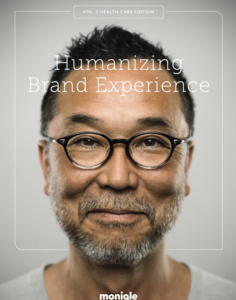3 Important Takeaways from Monigle’s 2019 Humanizing Brand Experience Report
// By Daniel Fell //
 The latest release of Monigle’s Humanizing Brand Experience report lays out a wealth of new information and insights into understanding what makes strong health care brands today, as well as challenges that health care leaders face in achieving higher levels of brand engagement and brand loyalty.
The latest release of Monigle’s Humanizing Brand Experience report lays out a wealth of new information and insights into understanding what makes strong health care brands today, as well as challenges that health care leaders face in achieving higher levels of brand engagement and brand loyalty.
The report itself is based on a survey of more than 17,000 consumers nationally (divided into a national sample and sampling among the 33 specific markets that they chose to look at on an individual health care brand level), 600 health care providers, and the company’s own assessment of factors that drive brand experience in the health care industry today. In combination, the study provides a broad look at the challenges and opportunities inherent in health care branding — as well as some granular insights and detail that will prove useful to marketers and health care executives.

The second edition of Monigle’s 80+ page e-book Humanizing Brand Experience includes brand rankings for 118 health systems.
While a large number of interesting points and thought-starters are presented within the 80+ pages of Humanizing Brand Experience, here are three important takeaways that marketers should consider focusing on:
Health care is making progress toward being more consumer-driven, but consumers are evolving even faster in their expectations and demands.
While this point isn’t drawn specifically from quantitative consumer research Monigle conducted this year, it is inferred from the data and a set of questions that attempts to better understand how consumers interact with health information and health needs in a broader sense.
Market forces in the form of more consumer-driven health insurance plans and new retail health care disruptors are leading consumers to expect more from their health care experiences. As a result, consumers are more engaged, and they research options much earlier in their care journeys. In addition, they are becoming more sophisticated and advanced in their understanding of “value” both on an intrinsic emotional level (confidence in their care) and on a symbolic or financial value level (satisfaction in how they spend their money).
Thus, it behooves health care leaders and marketing professionals to understand this not just on a general industry trend level, but also at a more granular, practical level that should be translated into rethinking and redesigning care experiences. Identifying and meeting specific consumer expectations — for example, lowering stress levels and reducing surprises for patients wherever possible — is key.
The rapid growth of health care systems presents unique opportunities and challenges for delivering on patient and consumer experience.
The American Hospital Association has long touted the 5,000+ hospitals across the U.S. While that number may still be technically accurate, the reality is that the unprecedented pace of hospital mergers has resulted in fewer and bigger systems of hospitals, physicians, and health care services under umbrella brands that may or may not mean much to consumers.
Health care is also quickly moving from in-hospital care to outpatient and home-based care, further blurring the identity of health care brands that consumers have known.
The Monigle report highlights two important “systemness conundrums”:
- Consumers are beginning to anticipate and expect more from their local health care systems, and those expectations exceed the rate at which the systems deliver on perceived benefits.
- Stress and burnout among all ranks of health care professionals — but especially among physicians — is at an all-time high and is often exacerbated within large health systems undergoing tremendous change and evolution.
While the authors don’t delve into the subject in depth, they do astutely point out that one possible solution is a much tighter collaboration between marketing and HR teams. Given the huge importance of the human element in health care, this is spot-on and goes right to the heart of successful brand building in the industry.
Building a strong health care brand requires delivering on both the emotional and functional expectations of health care consumers.
The basis for Monigle’s Health Care Brand Rankings, a listing of the top 118 health care brands in the 33 markets studied, is a value analysis approach to identifying and understanding consumer expectations for various factors in two categories across both stated and derived scales of importance:
- Emotional motivators: the “how” of health care
- Functional drivers: the “what” of health care
From this analysis, health care marketers can begin to zero in on those key motivators that drive brand loyalty in both the emotional and functional categories.
Health care brands that score high on the functional motivators (quality outcomes, personalization, and convenience and ease) are doing a great job of delivering on “what” health care institutions are in business to do — mainly deliver care.
Health care brands that score high on emotional motivators (individualization, well-being, freedom, success, security, and confidence) excel in “how” they deliver the care — or the brand experience.
And taken together, brands that score the highest combined scores in both categories are, in Monigle’s determination, the strongest. Not surprisingly, they expect to see considerable movement in the list from year to year. While aggregated lists of top-performing institutions like this are always interesting to consider, understanding how to meet health care consumers on both the emotional and functional levels is the most important takeaway for health care leaders.
In summary, the 2019 Monigle Humanizing Brand Experience report builds on the foundational work of its first study, and provides a rich source of information, insights, and ideas around building exceptional brand experiences for marketers to incorporate into their strategic planning efforts. But putting this information to work requires more than a simple understanding of the data and findings. In many cases, it requires rethinking and redesigning how health systems deliver health care today in an effort to make the future experience of health care even stronger. To that end, this report can be an important tool in that process.
Daniel Fell is a marketing and brand consultant and president and co-founder of Corner Street Strategies in Chattanooga, Tennessee. He is a member of the eHealthcare Strategy & Trends Editorial Advisory Board.

